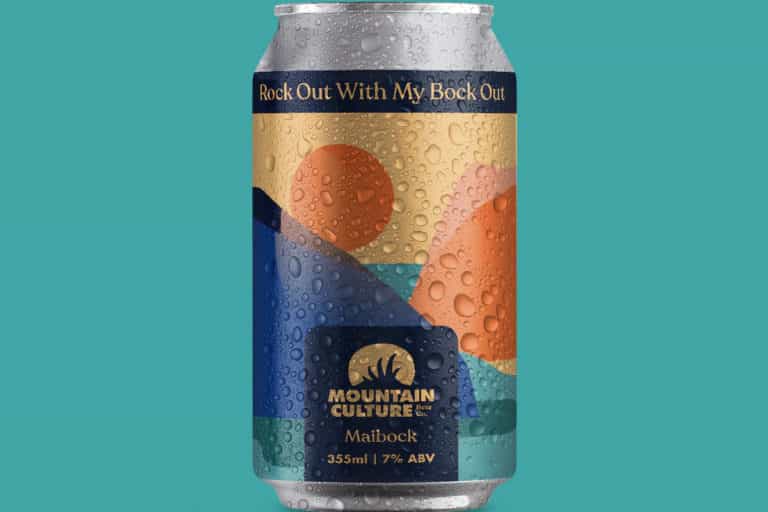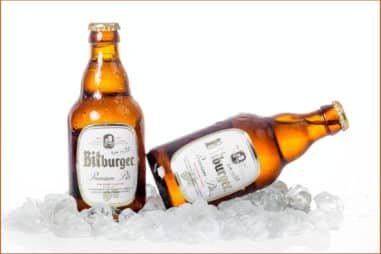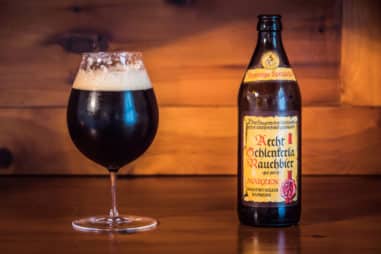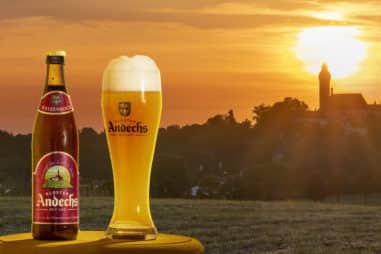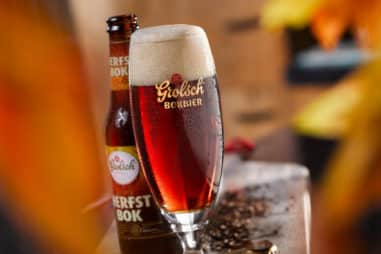Maibocks aren’t the most popular Bocks.
Is there a reason for that? It could be because they aren’t as widely produced.
But it might also be due to how some think Maibocks are the same as traditional Bocks. Or even a Marzen.
These styles are fundamentally different from one another. And this guide is here to give you everything there is to know about a Maibock.
What Makes a Maibock Beer?
A Maibock is a type of Bock beer, so malt-centric flavors are bound to be present.
Compared to other Bocks, a Maibock will always have a pale amber or golden color. Doppelbocks, traditional Bocks, and Eisbocks, for example, are all dark lagers.
But what truly makes a Maibock beer is its distinct hoppiness and bitterness.
No – not as hoppy or as bitter as an IPA. Not even close to an IPA’s bitterness. But for a Bock? Definitely more bitter.
Because Bocks are malt-dominant lagers, you taste 95% malt and 5% bitterness. The style in itself says that hop aroma and flavor should be low.
Most of the Bocks fall in an IBU between 15 to 22. That’s incredibly low compared to an IPA with an average IBU between 55 to 70.
For a Maibock, the IBUs can climb a little higher, reaching as high as 31 IBUs.
At that level, you can distinctly taste bitterness and hoppiness. In the case of a Maibock, these flavors lean more towards earthy or floral hoppy notes.
In the later sections, you’ll learn more about the style guidelines of a Maibock from its appearance down to its mouthfeel.
Difference Between Maibock and Marzen
Put simply, a Marzen is sweeter and has a stronger caramel malt flavor.
Maibocks, on the other hand, are stronger, more biscuity or light toasted, and have a drier finish. Not to mention, a stronger hoppy presence than a Marzen.
Think of a Maibock as a beer that you’d drink during the spring. Floral and earthy tones match the spring quality you’d expect in a beer.
As for a Marzen, it’s more of a beer you’d drink during fall. According to the Beer Judge Certification Program (BJCP) Guidelines, both styles are similar in some ways. For example, both a Maibock and Marzen will have moderate hop bitterness. Both can also have toasted notes.
However, the appearance of a Maibock is different from a Marzen’s. Maibocks have a pale amber to deep golden appearance. Marzens will have an orange-amber to reddish-copper appearance. A Marzen also shouldn’t be golden.
That’s one difference between the two lagers.
Second, a Maibock can have a biscuity flavor profile with light caramel flavor notes. Marzens that have biscuit, caramel, or roasted flavor notes are inappropriate in the style.
Third, Marzens should have low to no hop flavor while a Maibock can have a moderate hop flavor. The hop flavor you’d find in a Maibock reveals spicy or peppery notes.
That said, it’s pretty clear how different a Maibock is from a Marzen.
Difference Between Traditional Bock and Maibock
A traditional Bock will have a stronger malty flavor than a Maibock. Although Maibocks and Bocks tend to be seen as the same Bock beer, the truth is that they’re both quite different.
Appearance-wise, a Maibock is light- or straw-yellow golden compared to a Bock’s darker appearance. Yes — both are clear but it’s quite obvious since Maibocks are, after all, also referred to as a pale Bock.
Another important difference is the hoppy presence in a Maibock. Traditional Bocks don’t have a hoppy presence at all. Not to mention, a Maibock will have a higher IBU than a traditional Bock too.
What Does Maibock Mean?
To understand what a Maibock means, here’s a quick breakdown of what “Mai” and “Bock” stand for:
- Mai: translates to and is German for “May.” The term “Mai” refers to Maibocks being transitional beers that monks would drink during the short Bavarian spring.
- Bock: refers to a strong beer or dark, strong lager.
Maibocks were actually a springtime beer alternative to the malty richness of a traditional Bock. It’s why the style has a stronger hoppy presence than other Bock beers.
However, another term Maibock is commonly known for is Helles or Heller Bock. This translates to a pale Bock.
You can easily guess why it’s a pale Bock, right? Take a look at a traditional Bock. Its appearance ranges from copper to a dark-brown color. Maibocks are pale amber to deep golden.
Doppelbocks are deep gold to dark brown in appearance. Put these Bocks side by side and it’s clear that a Maibock is paler and lighter; hence the name pale Bock.
How Do You Pronounce Maibock?
A Maibock is pronounced as “Mai · Bock.”
Some might pronounce it simply without the slight pause in between Mai and Bock. However, this is only due to a person’s accent.
You can pronounce it as “Mai · Bock” or “Maibock.” Either way, people would still understand you’re referring to the German-style Maibock.
What Kind of Beer Is Maibock?
A Maibock is a lighter Bock brewed with more hops than its Bock siblings. In other words, a hoppy presence shines through more in a Maibock than in any other Bock.
Malt-centric flavors are still present, giving it a toasty flavor note or malty breadiness quality. However, a Maibock will also have spicy and peppery notes with some bitterness due to the Noble hops used.
Compared to a Doppelbock, think of a Maibock as the opposite – a lightened pale or golden Bock. The malts used in a Maibock are Vienna, pale Pilsner, and Munich malts.
It’s also associated with a transitional beer known for monks to drink during springtime in Germany.
But just because it’s a lighter Bock, its ABV still packs a strong punch as you would expect from any Bock.
Is a Maibock an Ale or Lager?
Maibocks are a lager but a strong lager at that. From the definition of Bock meaning strong beer, a Maibock will have a stronger alcohol strength than your typical lager.
In fact, all Bocks are considered lagers except for one: Weizenbock.
Weizenbocks are classified as ales because they use a Weizen ale yeast strain similar to what’s used in a Hefeweizen. A Maibock, on the other hand, will use a lager yeast strain, such as Wyeast 2206.
It’s important to note that what distinctively differentiates lagers from ales is the type of yeast used.
Appearance and flavor profiles can be used to describe how a lager differs from an ale. However, this can be difficult when you’re comparing lagers and ales that have nearly similar flavor notes and appearances.
Alcohol strength also doesn’t differentiate a lager from an ale. You’ll find that IPAs can range in the same ABV strength as a Bock.
The best way to tell the difference between an ale and a lager is the fermentation technique and yeast strain.
Ales use top-fermenting yeast and ferment at warmer temperatures of 60°F to 70°F (15.6°C to 21°C). Lagers use bottom-fermenting yeast and ferment in colder temperatures of 30°F to 50°F (-1°C to 10°C). As a result, lagers take longer to ferment – about 6 to 8 weeks – due to the cold temperature.
And finally, ales have a stronger detectable ester presence. This is due to the fact that esters are produced in greater quantities in warmer temperatures. Lagers have a clean profile, but ester flavor notes are either low or none at all.
Compare the flavor profile of a Weizenbock to a Maibock. A Maibock doesn’t have the banana, vanilla, or clove ester notes a Weizenbock has.
And that’s mainly because a Weizenbock uses an ale yeast strain. The fermentation technique of a Weizenbock allows the esters found in the ale yeast to shine and become present in its flavor profile.
Is Maibock an IPA?
Maibocks are like the antithesis of IPAs. In other words, they’re the opposite of what an IPA should be.
IPAs are hoppy beers. Not to mention, they have a bitter punch you immediately taste after your first sip. And then there’s the fruity or citrus notes of an IPA. Maibocks won’t have these notes. Neither will a Maibock have that bitter punch. Instead, Maibocks give a good kick, but in regards to alcohol strength.
Since Maibocks are malt-centric brews, it leans far from IPAs which are hop-dominant beers. In an IPA, it’s all about the hops. In other words, hops take the center stage while maltiness is only a faint flavor quality.
Sure – Maibocks might have slightly more bitterness and hoppy flavor than any other Bock.
However…
That doesn’t make a Maibock a hoppy beer. No Bock would ever be considered a hoppy beer, in fact. Finally, considering how Maibocks have roughly 31 IBUs, it pales in comparison to an IPA that can go as high as 70 IBUs.
How Would You Describe a Maibock?
For starters, a Maibock would be refreshing, crisp, and bright. As they say, you drink beer with your eyes. And if you were to see a Maibock sitting on a bar counter, that’s the kind of visual impression you would expect to taste.
Looks can be deceiving, though. Not in terms of flavor, but its strength.
Maibocks despite their lighter appearances are still strong beers. After all, it’s a Bock.
A Maibock looks refreshing and bright. Combined with its pale golden color, it’s definitely a refreshing beer you’d want to get your hands on during springtime evening.
What Does a Maibock Taste Like?
A Maibock will have a good balance of light toasty maltiness and sweetness. The slight hoppy bitterness also balances with the sweetness of a Maibock.
Ultimately, the rich pale-malt flavor dominates in a Maibock. Just like a traditional Bock, malt flavors take the center stage. Compared to a Doppelbock, a Maibock isn’t as malty due to the higher amount of hops added.
Take note. Doppelbocks have a very rich malty flavor. Although Maibocks are malt-dominant, they shouldn’t taste too malty either.
You’ll also taste spicy and peppery hop-flavor notes in a Maibock. Some caramel notes may be present, but it should only be light caramel notes. If the caramel notes are dominant, it’s inappropriate in a Maibock.
Finally, a Maibock will have a dry, crisp or refreshing finish. However, don’t mistake this pale Bock for a light lager. It’s still as strong as any other Bock.
Style Guidelines of a Maibock
When you’re brewing a Helles Bock or Maibock, it always helps to use the BJCP style guidelines as a reference.
The style guidelines listed below are taken from the Beer Judge Certification Program site.[1]
| BJCP Maibock Style Guidelines | Explanation |
| Appearance | Deep gold to light amber appearance. Lagering a Maibock should provide good clarity. As for the head, it should be large, creamy, and persistent. |
| Flavor | Continental European pale malt dominates the flavor profile. This mostly comes from the Pils malt along with toasty notes and melanoidins. Caramelization should be little to none. For the hop flavor, it should be moderate to none.
Low spicy and/or peppery notes is acceptable. Hop bitterness is also moderate and provides balance to the brew. The overall taste should be clean with no diacetyl or any fruity esters. Finally, it should have a moderately dry finish that tastes of both malt and hops. |
| Aroma | Malt aroma should be moderate to strong with a light toasty quality and some melanoidins. Hop aroma should be low to none, mostly with a spicy quality. There should also be no diacetyl and fruity ester aroma is low to none. |
| Mouthfeel | Maibocks should have a medium body with moderate to moderate-high carbonation. Even with increased bitterness, a Maibock should be smooth and clean. No astringency or harshness should be present. Lastly, some alcohol warming may be present. |
| Notes | The best way to describe a Maibock is it’s a pale version of a traditional Bock. A Maibock’s maltiness is not as rich as a traditional Bock. Overall, it’s drier, hoppier, and more bitter than a traditional Bock. |
How to Brew Maibock
Brewing a Maibock is about getting the right malt profile and hops. A common mistake first-time homebrewers make is they go too heavy when brewing a Maibock.
In the end, you get a traditional Bock instead of a Maibock.
This happens when you add too much Munich malt or even melanoidin malt to achieve a malty character. Now, this isn’t exactly a bad thing. But there are limits to how much Munich malt you should add.
Using too much Munich malt might leave you with a Maibock that’s either too heavy or close to the maltiness of a traditional Bock.
But don’t worry. This is an easy fix.
Rather than pump up your grain bill with Munich malt, keep your Munich to at least 20%. To balance it out, add 40% Marris Otter. You won’t regret it.
As for your Pilsner malt, go with 40%. With this grain bill, you get a nice bready Maibock without making it too heavy.
But what about specialty malts? For a Maibock, it’s not necessary. Crystal and caramel malts don’t fit the style of a Maibock. It’s worth noting that you could easily add too much caramel malt that your Maibock ends up having a sweet caramel flavor.
Now, if that’s not enough to convince you, adding Carahelles in very small amounts should be fine. Acidulated malt also works if you want to give your Maibock a lighter appearance.
Overall, a good sample grain bill to start with would be:
- 40% Pilsner malt
- 40% Marris Otter
- 20% Munich malt
If you find that your Maibock tastes a little dull, you can experiment with the Munich and Pilsner malt ratios.
For example, you can bump up your Munich malt to 30% and then lower your Pilsner malt to 30%. Some might even go for 40% Munich and 20% Pilsner. As for your Marris Otter, keep your British pale malt at 40%.
What Hops Should You Use in a Maibock?
Hop varieties are straightforward in a Maibock. Remember: Even if Maibocks have a slightly more hoppy presence, that doesn’t mean it should be dominant. In other words, hop presence is kept to a moderate level. As for hop aroma, this will be between low to none at all.
So, which hop variety should you use? It depends on whether you want slightly more bitterness or a noticeable hop flavor in your Maibock.
If you want slightly more bitterness, go with Magnum or Galena. For more hop flavor, Mt. Hood or Hallertau are great options.
Other hop varieties available in this style include:
- Perle
- Spalt
- Sterling
- Tettnanger
Normally, you’d add 0.5 oz. to 1 oz. (14–28 g) of your hops during the 60-minute kettle boil. Then, if you want a little more hop flavor, add another 0.5 oz. with 15 minutes left in the boil.
For example, if you plan to use Mt. Hood, you can add 0.5 oz with 60 minutes left in the boil. Then, add another 0.5 oz. with 15 minutes left in the boil.
Some might add 1 oz. of Sterling hops with 60 minutes left in the kettle boil. Then, another 1 oz. with 15 minutes left.
As a fellow homebrewer, hop variety is completely up to you. Just be sure to keep your Maibock’s IBU within 23 to 31.
What’s a Good Starter Yeast Strain for a Maibock?
For a Maibock, go with a yeast strain that…
- Has good attenuation
- Contributes a malty profile
- Doesn’t produce a lot of sulfur
- Provides a clean lager-fermentation character
You’ll find there are several great yeast strains for a Maibock, such as:
- White Labs WLP830
- Munich Lager yeast (2308)
- German X Lager (WLP835)
- Bavarian Lager (Wyeast 2206)
- Hella Bock Lager (2487-PC)
- Imperial Yeast-Harvest (L17)
- German Bock Lager (WLP833)
- Mangrove Jack’s Bavarian Lager (M76)
Wyeast 2206 and White Labs WLP830 are great starter options if it’s your first time brewing a Maibock.
Mash Temp for a Maibock
Since Maibocks are light lagers, you don’t want your mash temp too high. A mash temp between 151ºF to 153ºF (66°C to 67°C) should turn out great. Between decoction mashing and single-step mashing, it’s best to take the practical option if it’s your first time.
However, if decoction mashing floats your boat, be sure to keep each decoction boils at 10-minute intervals. Why? Mainly to keep your Maibock light. Finally, the most you could go is a triple-decoction mash, but a double-decoction mash should give you great results already.
Take note though.
This should be a 90-minute boil. Why? Because Pilsner malt carries more S-methyl methionine, which is a precursor to dimethyl sulfide. If there’s too much DMS in a Maibock, it’s not going to taste great. Instead, you’ll get off-flavors in your beer. So, boiling it for 90-minutes will drive the DMS away.
If you taste a little DMS in your beer, that’s okay. In fact, the style guidelines state it’s okay for a Maibock to have a little DMS. However, if your DMS is too high, you’ll taste a cabbage, vegetative flavor.
Finally, your mashout should be at a temperature of 170°F (76.7°C) for 5 minutes followed by sparging.
How to Ferment a Maibock
First things first. Make sure you pitch a healthy yeast starter. For lagers, you’ll need to pitch twice as much as yeast.
So, if the general standard is 0.75 million cells, you would need 1.5 million cells at least for a lager.
If you’re using liquid yeast, then 4 to 5 packs should be sufficient. For dry yeast, two 11.5-gram packs should be enough.
For fermentation temperature, start at 50°F (10°C) then slowly let the fermentation temp rise by 1 or 2 degrees on the 3rd day. Fermentation should last about 10 to 14 days. This is important because you also want to set aside enough time for a diacetyl rest.
More importantly, this will help ensure you don’t get any ‘hot’ alcohol in your finished beer.
How Long to Lager a Maibock?
Lagering a Maibock requires a ton of patience and time, but it’s worth the wait. A good temperature for lagering a Maibock is 30°F (-1°C). As for the time it takes, anywhere between 2 to 6 months should be good.
Now, if you can’t wait, you can try 6 weeks of lagering. However, it’s better to let your Maibock lager longer and move on to your next brew. This will all be worth it in the end.
When Should I Drink Maibock?
After lagering your Maibock between 2 to 6 months, you can bottle your brew and drink it to your heart’s content.
Although, some will add finings like gelatin at the end to improve the clarity even further. This is an optional step, though.
If lagering a Maibock sounds too long, some recipes only lager theirs for about 4 weeks or 30 days. Of course, it’s completely up to you. However, a well-done Maibock with a good ABV strength takes about 2 months.
Personally, as a fellow homebrewer, give those 2 months of lagering a shot.
Who Makes Maibock Beer?
There are a ton of recipes online. All with varied hops and malt choices. But before you do any more research, here are several breweries that make Maibock beers and are worth trying:
| Maibock Beers Worth Trying | Brewery |
| Summit Brewing Maibock | Summit Brewing Company |
| Rogue Dead Guy Ale Maibock | Rogue Brewing |
| Andygator | Abita Brewing Co. |
| Hofbrau Munchen Maibock | Hofbrau Brewery |
| Ayiner Maibock Privatbrauerei | Ayinger Privatbrauerei |
| Carton Brewing Ron’s Steam Bock Haircut | Carton Brewing Company |
| Smuttynose Brewing Maibock | Smuttynose Brewing Company |
| Cultivator | Troegs Brewing Company |
| JosephsBrau Heller Bock | Trader Joe’s Brewing Company |
| Ganstaller Brau 07 Bock At Its Best – feat Amarillo Hopfen | Ganstaller Brau |
| Cloudwater From Afar | Cloudwater Brew Co. |
| Berkshire Maibock Lager | Berkshire Brewing Company Inc. |
| Altstadthof Maibock | Haubrauerei Altstadthof |
2 months of lagering sounds like a lifetime…
But when you have several Maibocks to try during the 2-month wait, it’s not as bad as you think.
Having a go with some of the best Maibocks today should give you a good comparison to your own homebrewed Maibock.
And if you find there’s some tweaking needed in your brew, have at it. Heck, you could even whip up another Maibock batch but with a different recipe.
Best Food to Pair With a Maibock
With a great Maibock sitting in your fridge, it’s worth having it with food that pairs well for an even better experience.
Any meaty dish or even bread dishes go well with a Maibock. Since a Maibock will have spicy or peppery hop flavors, any fatty or spicy dish makes the perfect food pair too.
Of course, cheese is a must for any cheese-lover – Swiss cheese to be exact. Got a cheese fondue? Go wild!
Spicy sausages, along with any Thai or Korean food also pair well. As you already know, Korean food is full of spicy food options. Kimchi? Sure, that works. But you could even go with toppoki or spicy ramen topped with cheese.
But if Asian food doesn’t sit well with your palate, it’s always good to go with any classic American dish. Burgers, hotdogs, steak, or any kind of beef grilled with a good char are excellent pairs for a Maibock.

